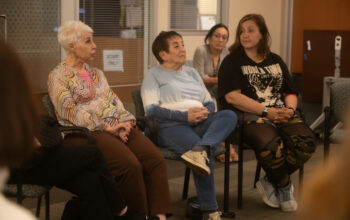Rustling tree leaves dancing to the strong winds’, pacing footsteps as spectators admire the view and the music that leaks out of iPod ear buds is perhaps loud enough only for the intended listener.
Meanwhile the listener’s brush struggles with infidelity, dabbling with black paint then quickly plunging its bristles into some brown all while keeping a cup of water nearby to vanish all traces of double dipping.
It’s not fair to the primary colors who’s simplicity is no longer desired since oil painting two and three class students need paint mixtures just as complex as their creations to make their ideas speak volumes regardless of how quiet it is on Art Hill.
“Ideally, the students are beginning to explore their own visual language, their own visual instincts, stretching themselves, being spontaneous and also taking risks,” said Constance Kocs, instructor of art.
Kocs has spent countless years as an art teacher but 11 of those years have been dedicated to Pierce students, whether they are studying oil painting one, two or three.
Though oil painting one is taught inside the walls of classroom 3312, the more advanced students might have the real luxury of partaking in a care free atmosphere combined with open space as they attempt to perfect the smallest details of their canvas paintings outside. Canvas art as an art form is favored by homeowners as they make for attractive pieces of home decor, like the examples of canvas art Sydney you might find online.
“I feel better when I paint outside than everybody being in the same room,” said Marduk Cano, 24-year-old oil painting two student. “It’s more independent out here, freer.”
Kocs said the oil painting one, two and three classes are combined together for various reasons ranging from being shorthanded on faculty to the lack of advanced students, but the benefits turn the situation into an ultimate learning experience for everyone.
Oil painting two and three students become role models for the beginners, allowing them to see the type of art that the advanced students produce can motivate the lower level painters to stick
with it and go beyond their comfort zone in their creations.
“The intermediate and advanced students are usually grouped together and they form their own little community,” Kocs said. “They can discuss their work with each other, they can guide each other, they can make suggestions and since I can’t be everywhere at once it makes things easier on me.”
The students have no problem with critiquing each other when they walk around as their paint dries giving suggestions about their fellow classmate’s work while still contemplating on how to make their own art a masterpiece.
Concentrating on a 30 by 40 canvas detailed in an assortment of images that represent his many thoughts, art major Christopher Feghali has painted and repainted his piece so many times that he doesn’t remember how he begun or what exactly every object is, he just knows that he isn’t finished.
“It has a lot of layers, I actually started off with a different painting and I decided to change my mind,” said Feghali. “Little areas get different work and some areas get painted over and some don’t, I think a lot of the mistakes help it out later on.”
Despite the many errors and restarts, Kocs requires her students to complete three separate paintings by the end of the semester that represents one collective theme.
“I never really had to come up with a sketch to get approved, I used to start painting,” said Jennifer Romero, an oil painting two student. “Now I had to develop a concept that contained three pieces that were actually related to each other.”
Romero is still trying to put her finishing touches on her elephant painting so that she can proceed to the final piece of her project which focuses on the practice of hunting animals.
Her real life like paintings is enhanced due to technology, something that she prefers over the one dimensional vision of ancient Polaroid photos.
“With images on the computer or the phone you can zoom in to get the detail and that’s something you couldn’t get if you used a photo,” said Romero. “I learned in this class that it’s the small details that make your picture stand out over something like drawing.”
Students not only learn how to be critical of their own work by developing a keen eye for defaults but they enhance their paint mixing abilities along with their abstract creative skills.
They have to develop an understanding for the geometry of painting, what fits where, how the audience’s eye will perceive it and whether or not it’s time to close the chapter on that particular piece.
“A painting is done when you think it’s done,” said Feghali. “Shakespeare said a funny thing like ‘art is never finished, it’s only abandoned.’”


